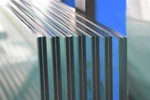
Vacuum glass, also known as vacuum glazing or vacuum insulated glass, is a type of glass that consists of two or more glass panes separated by a vacuum layer. The vacuum layer acts as an insulator, reducing heat transfer and improving thermal insulation properties compared to traditional double-glazed windows.
Vacuum glass is made by sealing the edges of two glass panes together, leaving a vacuum space between them. This vacuum space eliminates the convection and conduction of heat, resulting in improved thermal performance. It can provide better insulation than other types of glass, reducing heat loss and improving energy efficiency in buildings.
The benefits of vacuum glass include improved thermal insulation, reduced energy consumption, and enhanced comfort by reducing heat transfer through windows. It can also help to reduce condensation and noise transmission.
Vacuum Insulated Glazing VS traditional Insulated Glazing

Vacuum insulated glazing (VIG) and traditional insulated glazing are both types of window systems designed to improve energy efficiency and thermal performance in buildings. However, there are some key differences between the two.
Construction: Traditional insulated glazing consists of two or more glass panes separated by an air or gas-filled space, typically filled with argon or krypton gas. The space between the panes is sealed to prevent air leakage. In contrast, vacuum insulated glazing consists of two glass panes with a vacuum-sealed space between them. The vacuum eliminates the need for gas filling and provides better insulation.
Thermal Performance: Vacuum insulated glazing offers superior thermal performance compared to traditional insulated glazing. The vacuum between the glass panes significantly reduces heat transfer by conduction and convection, resulting in better insulation and lower heat loss. This allows for higher energy efficiency and improved thermal comfort in buildings.
Thickness: Vacuum insulated glazing is generally thinner than traditional insulated glazing. The vacuum between the glass panes eliminates the need for a thick gas-filled space, resulting in a slimmer profile. This can be advantageous for architectural design and allows for better integration into existing window frames.
Cost: Vacuum insulated glazing is typically more expensive than traditional insulated glazing. VIG's price is about three times of traditional insulated glass. The manufacturing process for VIG is more complex and requires specialized equipment to create and maintain the vacuum seal. This can make VIG a less cost-effective option for some applications.
Market Availability: Traditional insulated glazing is more widely available and commonly used in the construction industry. Vacuum insulated glazing is a relatively newer technology and is still being developed and commercialized. As a result, it may be less readily accessible and may have limited availability in certain regions.
In summary, vacuum insulated glazing offers superior thermal performance and a slimmer profile compared to traditional insulated glazing. However, it is generally more expensive and less widely available. The choice between the two will depend on factors such as budget, desired thermal performance, and availability in the market.
If you want to buy discount and quality vacuum insulated glazing (vig) made in China, you can contact Migo Glass which is one of the best manufacturers and suppliers of vacuum insulated glazing (vig) in China. We have a professional factory at your service, please feel free to wholesale cheap and customized glass products in stock at a reasonable price with us.Hot Tags: vacuum insulated glazing (vig) suppliers China, manufacturers, factory, wholesale, customized, cheap, buy discount, in stock, price, made in China









